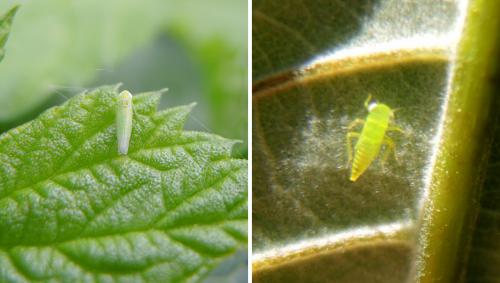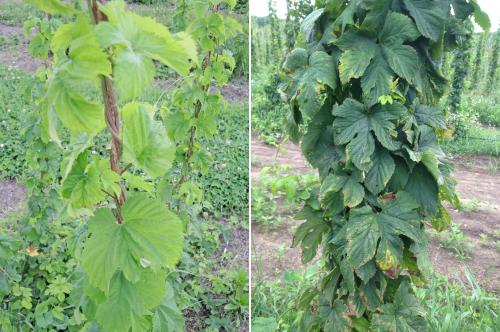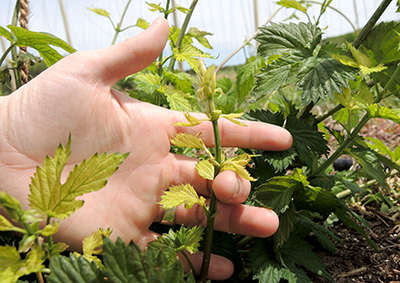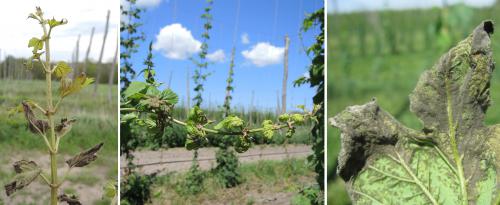Michigan hop scouting report – May 17, 2017
Potato leafhopper populations are low, continue scouting for downy mildew and monitor for building twospotted spider mite populations.

Stringing of hopyards is almost complete for most growers. Hop training has begun and will be completed almost entirely over the next two weeks. The first reports of potato leafhopper are trickling in. Continue applying fungicides to protect against downy mildew.
Potato leafhopper
Potato leafhopper populations are low as they are just arriving in Michigan. Like many plants, hops are sensitive to the saliva of potato leafhopper, which is injected by the insect while feeding. Damage to leaf tissue can cause reduced photosynthesis that can impact production, quality and cause death in first year plants.
Most injury occurs on rapidly expanding leaf tissue with potato leafhopper feeding near the edges of the leaves using piercing-sucking mouthparts. Symptoms of feeding appear as whitish dots arranged in triangular shapes near the edges. Heavily damaged leaves are cupped with necrotic and chlorotic edges and eventually fall from the tree. Severely infested shoots produce small, bunched leaves with reduced photosynthetic capacity. Symptoms of feeding damage are commonly referred to as “hopper burn.”
Adult leafhoppers are pale to bright green and about 0.125 inch long. Adults are easily noticeable, jumping, flying or running when agitated. The nymphs (immature leafhoppers) are smaller, pale green and have no wings but are very similar in form to the adults. Potato leafhoppers can’t survive Michigan’s winter and live in the Gulf States until adults migrate north in spring on weather systems. Economic thresholds have not been developed for potato leafhopper in hop.

Light green potato leafhopper adult (left) and bright green immature nymph (right).
Scouting should be performed weekly as soon as leaf tissue is present to ensure early detection and prevent injury. More frequent spot checks should be done following rain storms, which carry the first populations north and can be the source of new infestations all season. Scout at least weekly. The easiest way to observe potato leafhopper is by flipping the shoots or leaves over and looking for adults and nymphs on the underside of leaves. Pay special attention to succulent new leaves on the terminals of branches.

Overall yellowing associated with early potato leafhopper damage (left) and advanced potato leafhopper symptoms with chlorotic and necrotic leaf margins (right).
The most common classes of insecticides recommended for controlling potato leafhopper include the pyrethroids, neonicotinoids and organophosphates. Organophosphates are broad spectrum and can disrupt natural enemies and should only be used when necessary to rotate insecticidal mode of action or to target another pest at the same time.
Pyrethroids are also effective at controlling potato leafhopper and remain relatively inexpensive. However, pyrethroids have been shown to cause increases in mite populations in other crops and should be used judiciously, particularly early in the season when mite populations have time to build over the season. Neonicotinoids are longer lasting and narrow spectrum, making them a solid choice for management. For more information on chemical management, refer to the “Michigan Hop Management Guide” by Michigan State University Extension.
Downy mildew
Growers should continue to scout for downy mildew. Downy mildew is caused by a fungus-like organism called Pseudoperonospora humuli and can cause significant yield and quality losses in hop, depending on variety and disease pressure. In extreme cases, cones can become infected and the crown may die. Mild temperatures of 60-70 degrees Fahrenheit and regular rainfall during the growing season in Michigan provides ideal growth conditions for the fungus.

Emerging bine systemically infected with the downy mildew pathogen with stunting and chlorosis. Photo by Erin Lizotte, MSU Extension.
Basal growth originating from infected crowns or buds may appear distorted with shortened internodes that give them a stunted appearance and are referred to as downy mildew spikes. Infected leaves may develop angular, water-soaked lesions that follow leaf venation. Eventually, the water-soaked lesions turn brown and necrotic with fuzzy and gray-black asexual spore masses developing on the underside of infected lesions. The pathogen produces copious spores on the underside of infected leaves, which infect new tissue through the stomata.
As infected bines continue to grow, they may fail to climb the string. Growers can attempt to retrain new shoots, but often incur yield loss as a result. As the season progresses, symptoms may include stunted side-arm growth, tip die-back and cone discoloration. The fuzzy, visible growth of downy mildew is not always present and should not be relied upon as the sole indicator of whether infection is present.

Stunted downy mildew-infected spike with sporulation (left). Downy mildew infected bine with cupped leaves failing to climb the string (center). Downy mildew sporulating on the underside of a leaf (right).
Buds, growing points, cones and leaves are all susceptible to infection. Leaf infections produce a second source of spores, which can infect all parts of the plant, but is susceptible to desiccation under dry conditions. Infections occurring on the terminal growing point become systemic and can also produce spores, further contributing to the spread of infection. Once the fungus has become systemic, it grows down the plant toward the crown and can then persist in the buds and crown for a prolonged period. The fungus can also produce a resting spore and overwinter, but it is unclear how substantially these resting spores contribute to infection and how readily they are produced under Michigan conditions.
Scouting for downy mildew involves monitoring the crop for signs and symptoms of disease as soon as bines emerge in spring until senescence in the fall. Growers should keep records of their scouting, including maps of their fields, a record of sampling and disease pressure, as well as the control measures utilized. Scouting for downy mildew should begin as soon as plants begin to grow and should continue until the crop is dormant. Section your farm off into manageable portions based on location, size and variety and scout these areas separately. It is more practical to deal with blocks that are five acres or smaller and contain plants of the same variety, age and spacing.
Walk diagonally across the yard when scouting to ensure you view plants from both the edge and inner portion of the block. Change the path you walk each time you scout to inspect new areas. Revisit hotpots where you have historically encountered high downy mildew pressure. At a minimum, weekly scouting is recommended by Michigan State University Extension.
Unfortunately, even when we follow best management practices, downy mildew can gain a foothold in Michigan yards due to high disease pressure, poor fungicide timing, suboptimal spray coverage, fungicide wash-off, cultivar susceptibility or a combination of factors. In addition, fungicide resistance may play a role in some cases.
It takes a multipronged approach to manage for downy mildew. Growers should utilize a protectant fungicide management strategy to mitigate the risks of early and severe infections, but can also utilize cultural practices to reduce disease. Keep in mind that varieties vary widely in their susceptibility to downy mildew and select the more tolerant varieties when possible (refer to Table 2 in “Field Guide for Integrated Pest Management in Hops”).
Clean planting materials should be used when establishing new hopyards since this disease is readily spread via nursery stock. Growers should consider purchasing a few plants from prospective nurseries and have them tested for downy mildew before committing to a large numbers of plants, particularly if the grower hasn’t worked with the nursery before.
If disease is already present in the yard, diseased shoots and spikes should be removed by hand and healthy shoots retrained in their place. Remove superfluous basal foliage and lower leaves after bines reach 10 feet in height to promote air movement in the canopy and reduce the duration of wetting periods. If there is a cover crop, it should be mowed close to the ground. If yards have no cover crop, cultivation can help dry the soil and minimize humidity. Keep nitrogen applications moderate.
Lastly, growers need to apply fungicide treatments on a protectant basis as soon as bines emerge in the spring regardless of the presence or absence of visible symptoms of downy mildew. Dormant applications are not recommended. Applications should continue season long on a seven- to 10-day reapplication interval until harvest. The time between applications may stretch longer when the weather is dry and if hopyards don’t have active infections. Several periods in the season are particularly critical for disease control: immediately before and after training; when lateral branches begin to develop; bloom; and cone development. Covering young, developing bracts before cones close up is critical to protecting against downy mildew when conditions for disease are favorable. Ensuring adequate coverage on undersides of bracts, where infection occurs, becomes increasingly difficult as cones mature.
There are a number of effective fungicides registered for downy mildew control on hop in Michigan including Curzate, Forum, Revus, Zampro and Ranman. For a complete list of registered products, please refer to the Michigan State University Extension publication, “Michigan Hop Management Guide, 2017.” Please note that at this time Presidio is not available for use by Michigan growers.
Organic growers have fewer options and will need to focus on keeping tissue protected, selecting downy mildew-tolerant varieties and following cultural practices to limit downy mildew infection. Copper-based products are the mainstay of downy mildew management in organic hopyards and offer five to seven days of protection, but no post-infection activity. Products containing copper hydroxide have been shown to provide superior disease control in other cropping systems.
The pre-harvest intervals for copper formulations vary, so refer to the label. Actinovate, Eco-mate, Armicarb-O and Sonata are additional products that list downy mildew on the label and are approved for organic use in hops. The pre-harvest interval for these products are one day or less. At this time, we have no data on the efficacy of these products.
Twospotted spider mites
Looking ahead, growers should be carefully monitoring for building twospotted spider mite populations.
Stay connected with us
Please continue to visit the MSU Extension Hops website and the MSU Hops News Facebook page for up-to-date information, as well as sign up for the MSU Extension Hop & Barley Production Newsletter for current news articles and events. Also, please sign up for the new MSU hop listserv for a lively interactive discussion of all things hop-related. To subscribe:
- Send an email to listserv@list.msu.edu
- Leave the “subject” line blank
- In the body of the email type: SUBSCRIBE Hops
- You will receive a confirmation email directing you to click on a link (this is to avoid spammers). Click on the link.
- To send an email to the list once you have joined, just send it to hops@list.msu.edu
This material is based upon work supported by the National Institute of Food and Agriculture, U.S. Department of Agriculture, under Agreement No. 2015-09785. Any opinions, findings, conclusions, or recommendations expressed in this publication are those of the author(s) and do not necessarily reflect the view of the U.S. Department of Agriculture.



 Print
Print Email
Email


